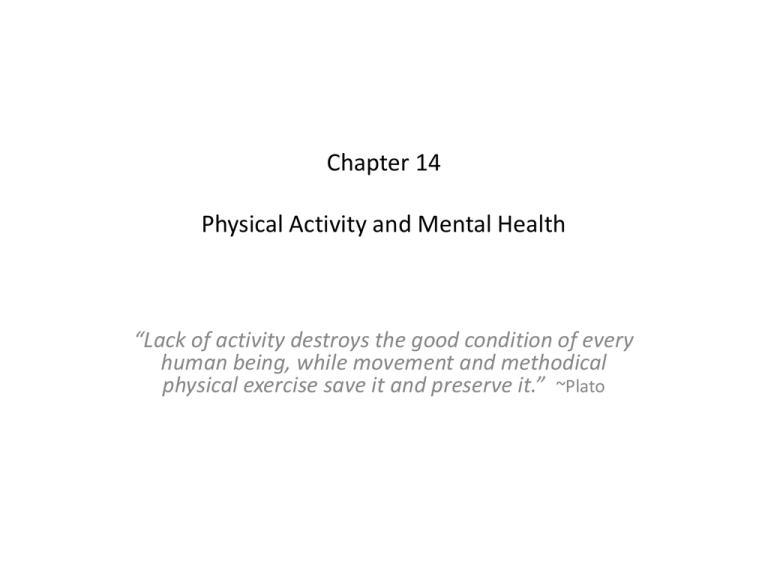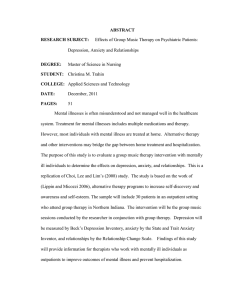Chapter 14 Physical Activity and Mental Health
advertisement

Chapter 14 Physical Activity and Mental Health “Lack of activity destroys the good condition of every human being, while movement and methodical physical exercise save it and preserve it.” ~Plato • • • • • • The WHO has projected that depression will be 2nd only to CVD as the world’s leading cause of death and disability by 2020 and will be 1 by 2030 ahead of CVD with dementia being 3rd. Accumulated evidence states that activity protects against depression and anxiety disorders as well as cognitive decline and dementia associated with aging. In the US the estimated costs of mental disorders are a combined 6.2% of health care expenditures. In the US dementia and other diseases of the CNS are leading causes of death and mental disorders account for more than 40% of years lost to disability. Exercise improves brain health through positive neurogenerative (new cells), neurotrophic (cell growth), neuroprotective (cell survival), neuroplastic (density and complexity of synapses), and vascular (better circulation) changes. A serious mental illness in the US costs about $16,000 in annual lost earnings, a total impact of $193.2 bill to the economy. • • • • • • • • Nearly half Americans will meet the criteria for at least one mental health disorder in their life, usually first in childhood or adolescence. Half of all lifetime cases start by age 14 and ¾ by 24. Rates of anxiety, mood and substance use disorders in the US differ according to age, sex and race. Suicide is the 2nd leading cause of death among 25-34 and the 3rd leading cause of death among 15-24 year olds. The father of American psychology, William James, recognized exercise as being important for decreasing worry and elevating mood at the turn of the 20th century. Hippocrates prescribed exercise for his patients suffering from depression. 17th century scholar Robert Burton (1632) noted in The Anatomy of Melancholy, sloth or physical inactivity had been regarded as a cause of depression since antiquity. Not only are anxiety and mood disorders the most prevalent mental health problems in the US they are also risk factors for cardiovascular morbidity and mortality. Depression • • • The APA recognizes 4 types of mood disorders: (1) depression (2) bipolar or manic depressive disorder (3) mood disorders due to a medical condition (4) substanceinduced mood disorder Depression can be major depression and the milder chronic form, dysthymia. Major: has 2 subtypes—melancholic and atypical depression. The 2nd type bipolar or manic—is characterized by periods of depression alternating with periods of elevated, expansive or irritable mood, exaggerated self-confidence, risky or asocial behavior or even paranoia. Etiology: Catastrophic events such as a major illness, loss of a loved one, loss of self esteem, chronic anxiety or stress. No direct genetic link has been found but some people are more susceptible. Regardless of cause depression is associated with imbalances in neurotransmitters which are chemicals that influence the activity of brain cells that regulate mood, pleasure and rational thought. • • • • • • Physical Activity and Depression: Psychiatrists used exercise to treat depression in the US in 1905. The benefits of activity for helping prevent depression occur regardless of age, sex, race or socioeconomic status. Physical activity and depression influence each other. Activity reduces depression but depression may reduce subsequent physical activity. Moderate and high levels of activity reduce the symptoms of depression compared to low levels of activity which nonetheless is more protective than inactivity or very low levels of activity. Maintaining fitness during middle age helps reduce risk of developing depression. Both aerobic and resistance exercises have a positive effect on patients diagnosed as having mild to moderate depression. Biological Plausibility • Several neurological mechanisms represent potential avenues by which exercise could influence physiological mediators of depression: • (1) Endorphin hypothesis: Elevations in endorphins following exercise produce improvements in mood. • (2) Brain blood flow hypothesis: Cerebral blood flow is increased with exercise and some of these areas can be involved with emotional and cognitive processes. Blood flow and O2 are increased to the frontal cortex. Because an increase in blood flow is associated with elevated cellular metabolism, enhanced blood flow to brain regions involved in the regulation of emotion could mediate changes in mood with exercise. • (3) HPA hypothesis: Disruption of the hypothalamic pituitaryadrenocortical (HPA) axis, the system that regulates much of the body’s endocrine response to stress, has also been implicated in causing depression. P-407 • • • • (4) Improved sleep: Insomnia increases psychiatric problems and exercise helps one get good sleep. (5) Monamine hypothesis: The neurotransmitters dopamine, norepinephrine and serotonin. Exercise helps release these. (6) Depression-like behavior: So called learned helplessness or behavioral despair common in human depression. Although moderate exercise during leisure time is associated with reduced risk of depression excessive training , especially in endurance sports, can result in depression in some athletes. Anxiety Disorders • • • • • • • • P-408 Anxiety is characterized by apprehension or worry and is typically accompanied by agitation, feelings of tension, and bodily arousal. Though anxiety can occur with depression, people most often have anxiety apart from depression. Anxiety is a common human experience during imagined or real threatening circumstances. State anxiety: when feelings of anxiety are temporary and fluctuate from moment to moment. Trait anxiety: If the feelings are constant and persistent. Anxiety disorders are illnesses that cause people to feel frightened, distressed, and uneasy for extended periods of time for no apparent reason. Phobias: an intense fear of an object, place, or situation. Social phobia: (social anxiety disorder): an overwhelming fear of scrutiny and embarrassment in social situations, which causes them to avoid many activities. Panic disorder: repeated episodes of intense fear that strike without warning and without an obvious source. • • • OCD- repeated, unwanted thoughts or compulsive behaviors that seem impossible to stop and it typified by repetitive acts or rituals to relieve anxiety. PTSD- A delayed or prolonged response to a stressful event or situation that was especially threatening or catastrophic. Symptoms include flashback, or dreams of the original trauma, an enhanced startle reaction and insomnia. GAD- recurrent or persistent excessive, uncontrollable worry about every day, routine life events and activities on more days than not for at least 6 months. Etiology of Anxiety Disorders • • • • • • • Just as people can have a depressive temperament, people can also, through genetics and early experiences, have an anxious temperament. Anxiety, like depression, is a stress emotion. Treatment of anxiety: Psychotherapy & pharmacotherapy. Physical Activity: The Evidence. P-413. Physical activity (regular) does seem to reduce feelings of anxiety but the evidence is minimal. Active people seem to have less anxiety symptoms than inactive people. The Distraction hypothesis states that exercise distracts attention from anxiety provoking thoughts and provides a time-out from cares and worries. Biological plausibility: Body warming—exercise causes temp increase in muscles to provide reduced muscle tension. Endorphins—Brain opioids could help with anxiety reduction—just like with depression. Body arousal—acute and chronic exercise can reduce muscle reflexes and tension. Brain neurotransmitters— serotonin, norepinephrine and GABA—exercise increases. • • • • • • P-420 Cognitive Function and Dementia: Dementia (taken from Latin, originally meaning "madness", from de- "without" + ment, the root of mens "mind") is a serious loss of global cognitive ability in a previously unimpaired person, beyond what might be expected from normal aging. It may be static, the result of a unique global brain injury, or progressive, resulting in long-term decline due to damage or disease in the body. Although dementia is far more common in the geriatric population, it can occur before the age of 65, in which case it is termed "early onset dementia".[1] Dementia is not a single disease, but a non-specific syndrome (i.e., set of signs and symptoms). Affected cognitive areas can be memory, attention, language, and problem solving. Normally, symptoms must be present for at least six months to support a diagnosis.[2] Cognitive dysfunction of shorter duration is called delirium. Especially in later stages of the condition, subjects may be disoriented in time (not knowing the day, week, or even year), in place (not knowing where they are), and in person (not knowing who they and/or others around them are). Dementia can be classified as either reversible or irreversible, depending upon the etiology of the disease. Fewer than 10% of cases of dementia are due to causes that may be reversed with treatment. Some of the most common forms of dementia are: Alzheimer's disease, vascular dementia, frontotemporal dementia, semantic dementia and dementia with Lewy bodies. • Evidence shows that physical activity delays the incidence of dementia and the onset of cognitive decline associated with aging.




